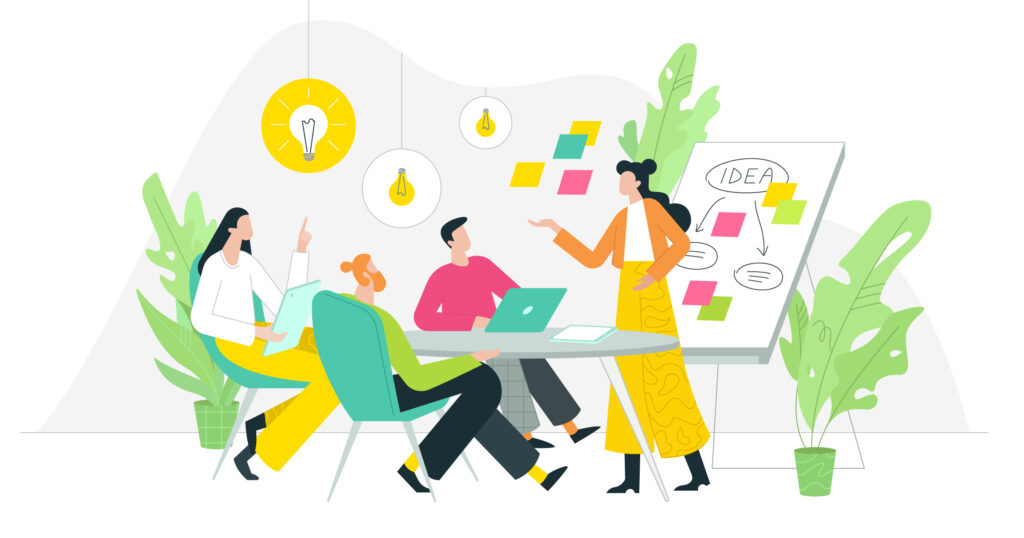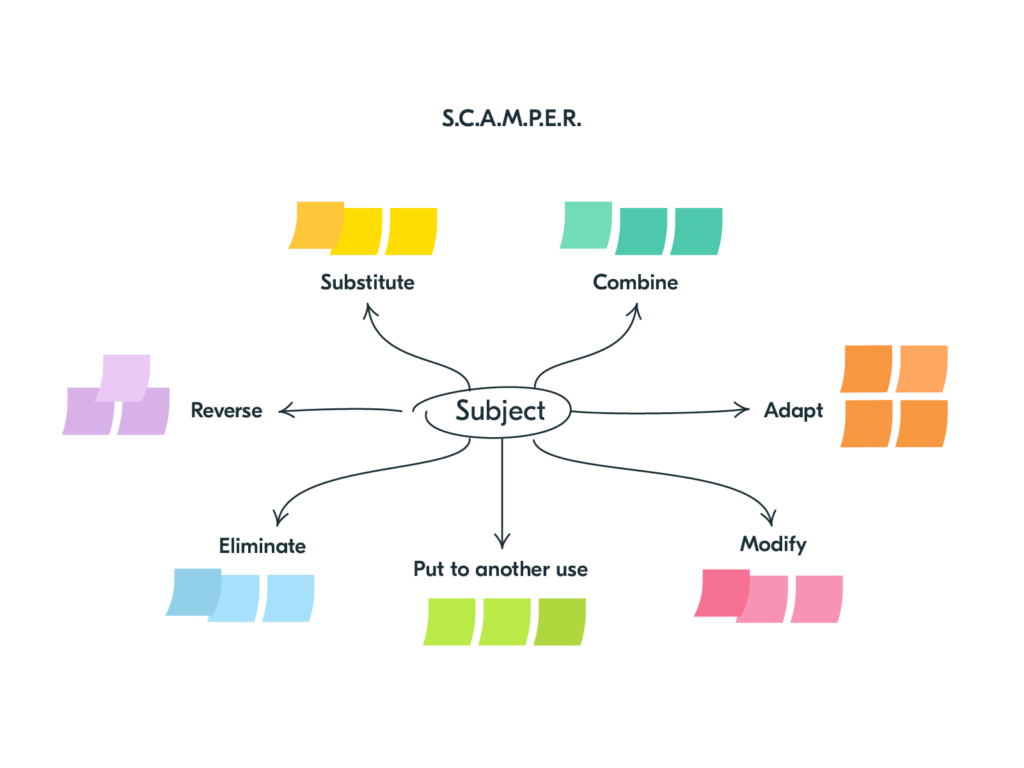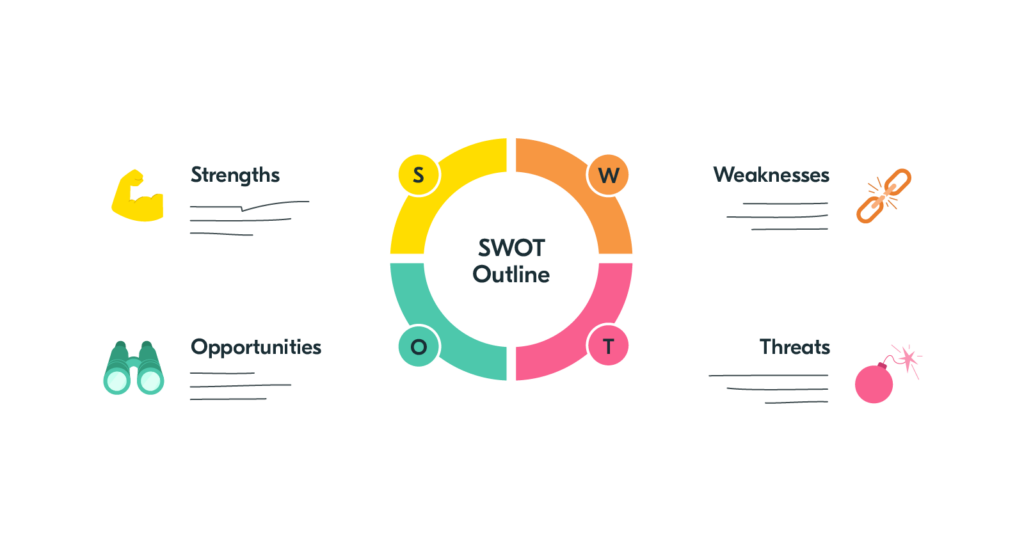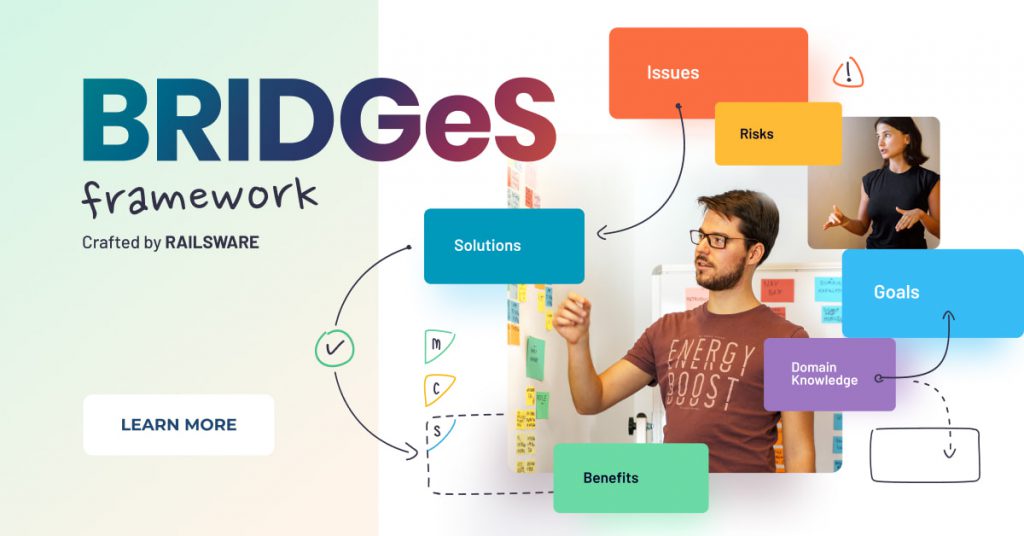
In this article, we’ll break down the steps of idea generation and discuss tried-and-tested methods of composing and developing a new product idea. We’ll also include a step-by-step guide on how to use Railsware’s own BRIDGeS framework, a robust tool for flexible ideation and decision-making.
Why the Ideation Stage is Important for New Product Development
The idea generation stage is pivotal to the product development process. It’s where you:
- Answer the big questions. Some of the biggest hurdles you will face throughout the new product development process appear during the ideation phase. Your team will have to answer questions like, what makes this new product idea unique? Who is the target customer? Does this new product idea actually solve the customer’s problem? By working out the answers to these questions, you will gain a deeper understanding of your customer’s needs, and what you are trying to achieve.
- Harness the creativity of your team. Product ideation is not a solo endeavor. The combined creative input of team members is invaluable when it comes to conjuring up a new product idea. Ideally, a well-chosen team of about 2-8 subject matter experts (SMEs) should be involved in an ideation session. For example, a typical session might include a product owner, product manager, a designer, and a software engineer. This would allow for a wide range of perspectives to be shared, challenged, or even joined together to create a pool of promising ideas.
- Put the customer front and center. Product ideation isn’t only about coming up with the best new product concept; it’s about choosing one that aligns with your company’s strategic goals, and more importantly, the needs of your potential customer. Your team must keep the customer at the forefront of their minds when teasing out a new idea.
Sources of Idea Generation
Gathering information from a wide range of sources is key to identifying (and ultimately solving) your customer’s pain points. Companies will often dip into more than one source at a time, and some will prove more valuable than others. Here are a few examples:
- Use industry knowledge to identify opportunities for automation.
Seek out the perspectives of team members or SMEs who have experience working in other industries (e.g. hospitality, retail, healthcare). They may be able to identify areas in those industries where certain internal processes or customer products/services could be automated or improved. Afterward, you can validate your findings by conducting market research. Not only will you gain insight into shifting customer behavior and emerging trends, but you will also ensure that your decisions are data-driven. When an idea is selected and moved up the line for approval, you will have the data on hand to defend its feasibility and potential ROI.
- Take something that already exists, and make it better.
Sometimes, there’s no need to reinvent the wheel; you’re better off finding ways to improve it. Start by performing an in-depth analysis of the competition. Can you identify a gap in their offering? If not, tune into what their customers are raving or complaining about — is there a way that your organization could do it better? Even if you don’t come up with an idea for a new product, you may uncover some insights into how to improve your existing products.
- Market the solution to a problem your organization has faced.
Find out if there are any practical issues your teams are facing. Have they scoured the market and struggled to find a solution to their problem? Is there some kind of tool or appliance you could create in order to solve it? It’s likely that other organizations are suffering from this issue too, which means you could potentially sell your solution to them. This is how Railsware came up with the ideas for our products Mailtrap, Coupler, and TitanApps. Our teams had a real need for each solution, so we initially developed the products as internal tools, before sharing them with the wider tech community. So far, it’s been a win-win for our team and customers!
- Leverage the knowledge of internal teams and stakeholders.
Nobody knows your customer better than those who are interacting with them daily: your R&D, sales, marketing, or engineering teams. That is why it’s so important for your organization to promote a culture of innovation and create opportunities for team members to exchange ideas. This will encourage employees to freely share concerns or solutions that can be shaped into new product ideas.
- Listen to the demands of your existing customers.
User feedback isn’t only good for identifying ways to improve your products; it can spark ideas for new ones too. Take into account the comments or complaints of your existing customers. Have they suggested an idea for a product that could satisfy an unmet need? Of course, not every suggestion is worth pursuing, but some may point your team in the right direction.
The Benefits of Structured Idea Generation
Although the concept of ‘structured creativity’ might seem like an oxymoron, it’s actually a useful way of approaching product ideation. There are several reasons why a structured idea-generation session may yield better results than a spontaneous brainstorm.
- Structure makes sessions more productive. Sessions are inefficient when everyone is just shouting out ideas to be jotted down on a whiteboard. By utilizing a framework, your team will be better able to share suggestions and stay focused on the task at hand.
- Structured sessions can help kickstart creativity. Most ideation frameworks include prompts or headings which draw out the answers to pertinent questions. Meanwhile, adopting a structured approach based on a framework allows participants to see new perspectives, which in turn can ignite creativity.
- Having structures in place from the very beginning sets the right tone for the remainder of the process. With a proper framework in place, your team will be able to think through an idea and create an implementation plan – whether you’re ready to launch the final product or in the idea validation phase.
For more on choosing the right option to validate your idea, refer to our PoC vs Prototype vs MVP guide.
Common Frameworks for New Product Ideation
After you’ve defined your problem, finished your research, and compiled your findings, it’s time to plan an ideation session. Among other things (such as sending out calendar invites and selecting your collaboration tools), planning will include choosing a framework that enables your team to shape a new product idea. It’s worth mentioning that such tools can be used for a variety of tasks, regardless of the size of your organization — see startup frameworks for more.
There are a few different kinds of ideation techniques, but the most commonly suggested frameworks are SCAMPER and SWOT.
How to Use SCAMPER
SCAMPER is a critical thinking technique that can be applied to ideation. It’s all about taking a fresh look at what’s already out there and putting your company’s spin on it.

SCAMPER is a combination of seven different techniques, namely (S) substitute, (C) combine, (A) adapt, (M) modify, (P) put to another use, (E) eliminate, and (R) reverse. The terms prompt you to reimagine every aspect of a problem in order to find the ideal solution.
How To Do a SWOT Analysis
SWOT stands for Strengths, Weaknesses, Opportunities, and Threats. Although it is mainly used as an idea screening tool, SWOT can be helpful for brainstorming too.
To begin a SWOT analysis, you must first decide on your subject or objective (e.g. develop a new tool for social media management). Once you have that in mind, you can proceed to list its characteristics. To explore the internal merits/drawbacks of your subject, list its Strengths and Weaknesses. To explore the external factors that may propel or hinder its success, list its Opportunities and Threats. It may also be helpful to perform a SWOT analysis on one (or more) of your competitors, in order to pinpoint their shortcomings.

Each of the above frameworks has its limitations. Although both are useful brainstorming tools, neither provide a clear path into the selection or implementation stages of new product development. Additionally, SWOT is better suited for the screening stage of ideation; its compact shape doesn’t provide much leeway for exploring the intricacies of a problem. At Railsware, we use the BRIDGeS framework to maintain clarity and consistency throughout the idea generation process. Here’s how it works…
Generating Ideas for New Products With BRIDGeS
BRIDGeS is a flexible decision-making and ideation framework designed by Railsware. It is a four-step process in which you analyze the Benefits, Risks, Issues, Domain Knowledge, and Goals of a Subject(s) in order to find the best solution — in this case, a viable new product idea.
Steps for Idea Generation in New Product Development
Before you dive into a BRIDGeS session, we recommend reading a little bit about how to prepare first. If you will be running a virtual session, you can download our Figma template. For in-person sessions, you’ll need a whiteboard, markers, and colored notes or cards.
When it comes to inviting participants, we recommend that your team include designers, engineers, members of the product team (e.g. product manager, business analyst, etc.), and other stakeholders who will be involved in the development process. For best results, invite between two and eight attendees.
Once you’re familiar with how BRIDGeS works, it’s time to put it into practice. Here’s what that entails:
- Describe the problem. Start in the Problem Space. Brainstorm possible Subjects, and list their descriptors. A subject can be anything from a user or institution to a role or strategy. Jot down every Benefit, Risk, and Issue and consider the Domain Knowledge and Goals relevant to the Subject(s). Each should have a designated color on the board which will help your team differentiate between them.
- Prioritize. Decide on the importance of descriptors once they’ve all been written down. This will allow you to focus on the essentials as you move forward. At Railsware, we favor the MoSCoW method. This involves tagging your descriptors with MoSCoW markers, stating what Must, Should, Could, or Won’t be done (this time).
- Explore Solution Variations. Now that your problem has been properly defined, you can move into the Solution Space. This is where you will discuss the form of your solutions and figure out which option makes the most sense. Above all, solution variations should address the Subject’s Goal you identified in the Problem Space.
- Break down the solution. This is where you will take a chosen solution variation and destructure it. During this final step, you will describe the solution through epics and nested tasks. Refer back to the Problem Space to identify which Benefits, Risks, and Issues need to be assigned a task or epic. You should also use MoSCoW again to prioritize accordingly.
BRIDGeS ideation sessions can last anywhere from 4-16 hours, depending on the complexity of your product idea. However, by the end of the session, you should have a list of epics and tasks ready to be transformed into a product development roadmap. To get a better sense of how the framework looks in practice, check out our Uber Case Study.
Key Benefits of BRIDGeS for Ideation
In the context of product discovery, BRIDGeS bears some advantages over other discovery tools, frameworks like SWOT and SCAMPER, or other approaches like mind mapping, storyboarding, and reverse thinking. For instance:
- It’s an all-in-one tool. Once you have wrapped up an ideation session, you won’t be left wondering how to make your idea actionable. BRIDGeS provides a logical path from ideation to implementation. By the end of the session, you should have a list of epics and tasks to begin working on immediately.
- It’s flexible. BRIDGeS allows you to explore multiple subjects simultaneously. This can help your team save time during ideation sessions and gain a better understanding of the problem’s complexities or contingents.
- It supports idea screening and selection. Idea screening is all about weeding out non-optimal ideas and identifying the ones that have real potential. Compared to other frameworks, BRIDGeS lets you dive deeper into the problem context and its solutions. This will ensure that an idea has been sufficiently analyzed and fleshed out before being selected.
Wrapping Up
Idea generation is arguably the most important step in the new product development process, but it doesn’t have to be frustrating, complicated, or tedious. Adding structure to brainstorming sessions can enhance your team’s creativity, increase engagement, and maximize synchronization. While there are many different kinds of ideation techniques and frameworks on the market, it’s essential to choose one that aligns with the goals of your product team. Frameworks like BRIDGeS can help ease the transition from idea generation to implementation. With the right structures in place, great ideas can be quickly transformed into powerful new products.
